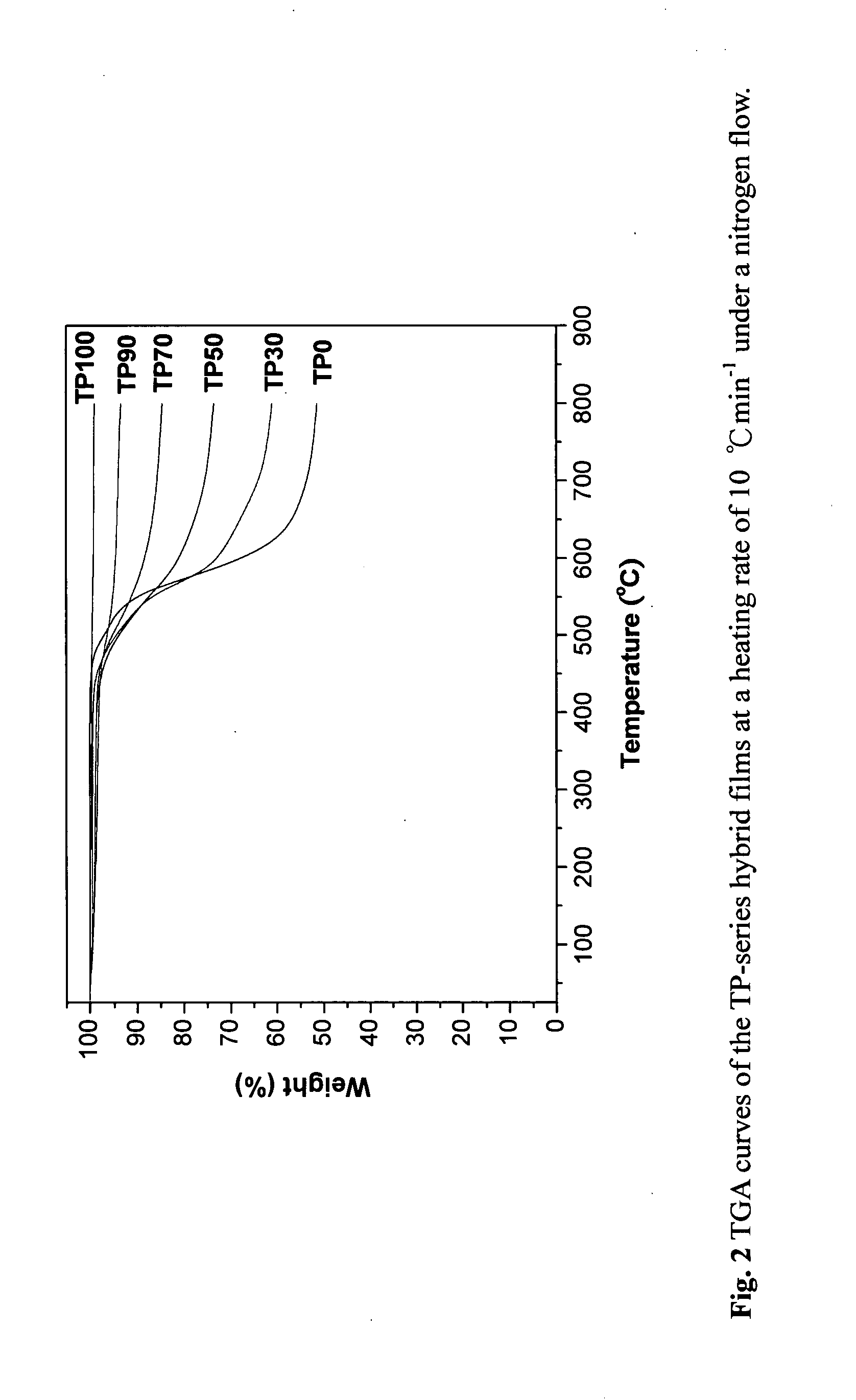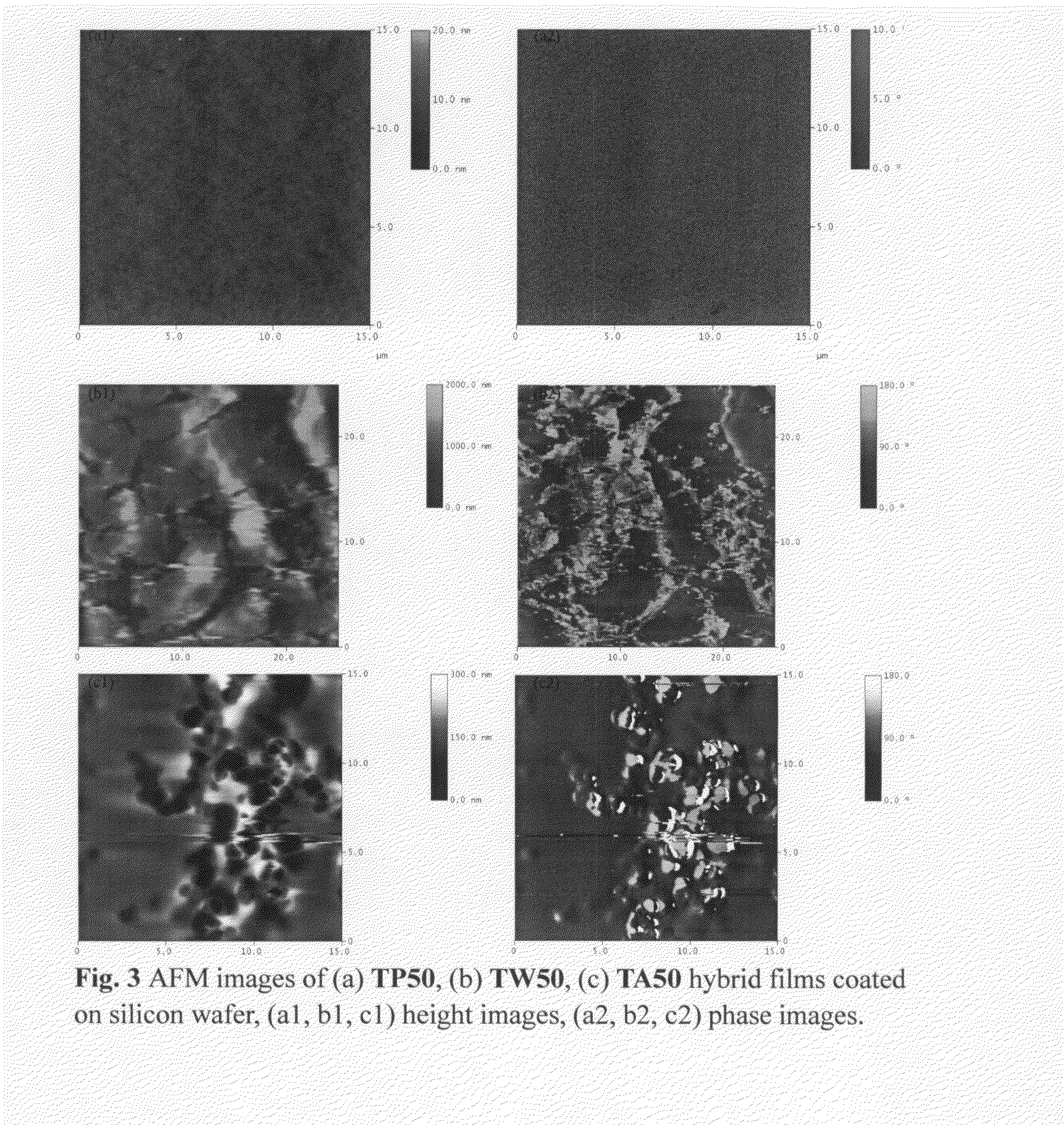Polyimide-titania hybrid materials, their preparation, and film prepared from the materials
a technology of polyimidetitania and hybrid materials, which is applied in the direction of pretreatment surfaces, liquid surface applicators, coatings, etc., can solve the problems of limited thermal stability of pmma moiety, restricted applications on optoelectronic devices, and uncontrolled aggregation, etc., to achieve good surface planarization, excellent thermal properties, and tunable refractive
- Summary
- Abstract
- Description
- Claims
- Application Information
AI Technical Summary
Benefits of technology
Problems solved by technology
Method used
Image
Examples
experimental examples
Material
[0040]4,4′-(hexafluoroisopropylidene) diphthalic anhydride (6FDA) and 4,4′-(hexafluoroisopropylidene) dianiline (6FpDA) were obtained from Chriskev company (USA) with a purity level of 99%. 4-aminobenzoic acid (4ABA), aniline, and titanium n-butoxide (Ti(OBu)4) were obtained from ACROS (Belgium) with purity levels of 99, 99.5, and 99%. All monomers were purchased and used without purification. Solvent, 1-methyl-2-pyrrolidinone (NMP), 1,3-dichlorobenzene (DCB), N,N′-dimethyl-acetamide (DMAc), and n-butyl alcohol (BuOH) were obtained from TEDIA. The acid catalyst of titanium n-butoxide, 37.5 wt % HCl, was used as received from Scharlau Chemie.
example 1
Synthesis of Organo-Soluble Polyimide with Carboxylic Acid Endgroups (6FDA-6FpDA-4ABA)
[0041]A solution-imidization technique was employed to synthesize the organo-soluble polyimide (6FDA-6FpDA-4ABA) with carboxylic acid endgroups as show in Scheme 323. The molecular weight and endgroup functionality could be achieved by controlling the reactant stoichiometry.
[0042]Firstly, 4,4′-(hexafluoroisopropylidene) dianiline (6FpDA, 3.34 g, 0.01 mol) was added into a 150 ml three-necked round bottom flask and 48 g of NMP was used to dissolve the reactants. 4,4′-(Hexafluoroisopropylidene) diphthalic anhydride (6FDA, 8.88 g, 0.02 mole) was slowly added into the above solution with vigorous stirring and nitrogen purge. The mixture solution was allowed to react for 8 h at room temperature. Secondly, 2.88 g (0.021 mole) of 4-aminobenzoic acid (4ABA) and 12 g of 1,3-dichlorobenzene (DCB) were added into the above solution. The 20 wt % polyamic acid (PAA) solution was formed after constantly stirring...
PUM
| Property | Measurement | Unit |
|---|---|---|
| Temperature | aaaaa | aaaaa |
| Temperature | aaaaa | aaaaa |
| Temperature | aaaaa | aaaaa |
Abstract
Description
Claims
Application Information
 Login to View More
Login to View More - R&D
- Intellectual Property
- Life Sciences
- Materials
- Tech Scout
- Unparalleled Data Quality
- Higher Quality Content
- 60% Fewer Hallucinations
Browse by: Latest US Patents, China's latest patents, Technical Efficacy Thesaurus, Application Domain, Technology Topic, Popular Technical Reports.
© 2025 PatSnap. All rights reserved.Legal|Privacy policy|Modern Slavery Act Transparency Statement|Sitemap|About US| Contact US: help@patsnap.com



